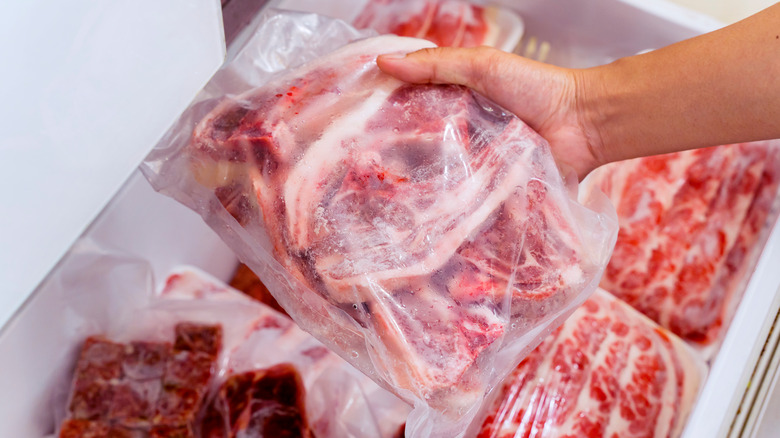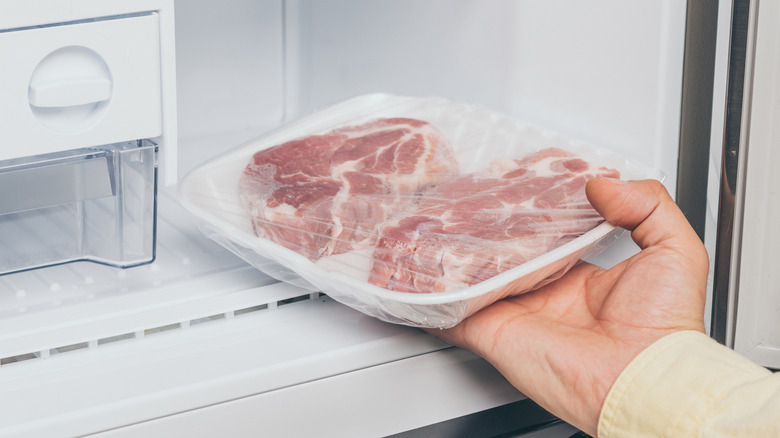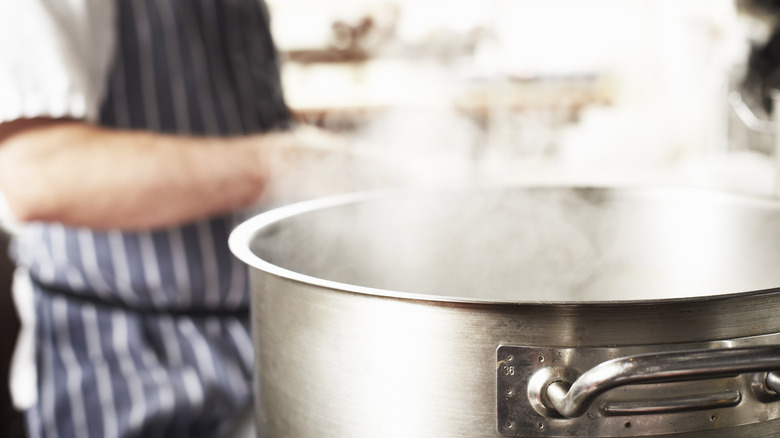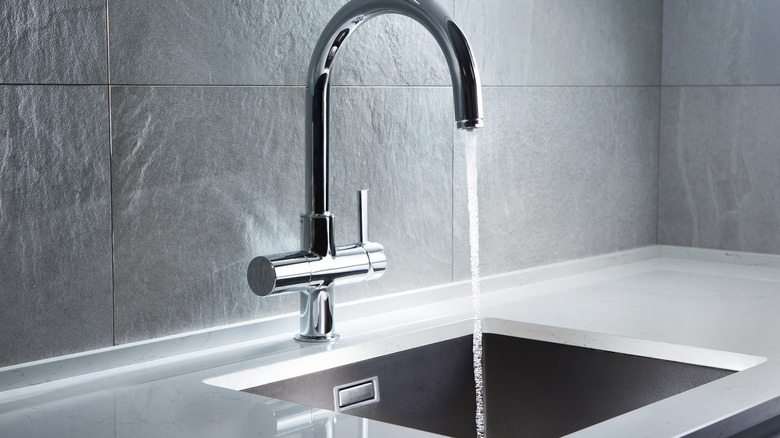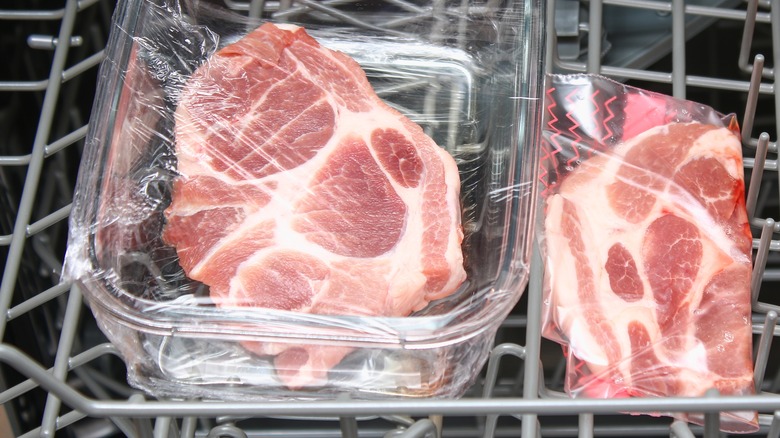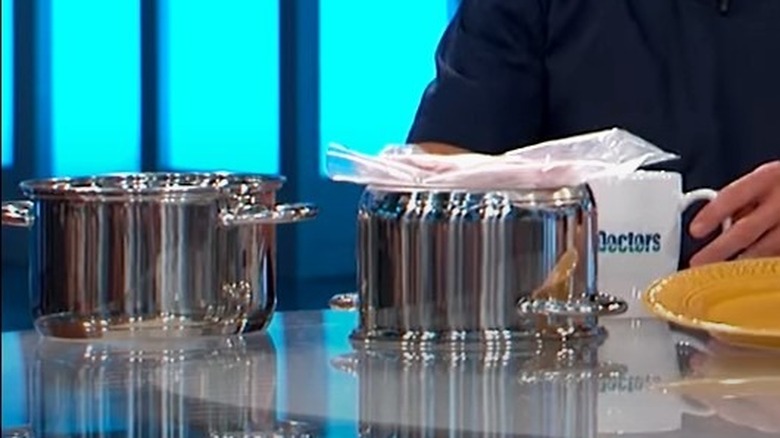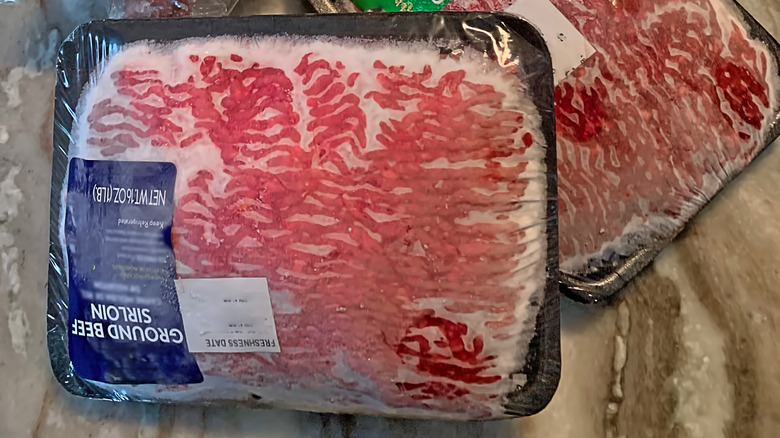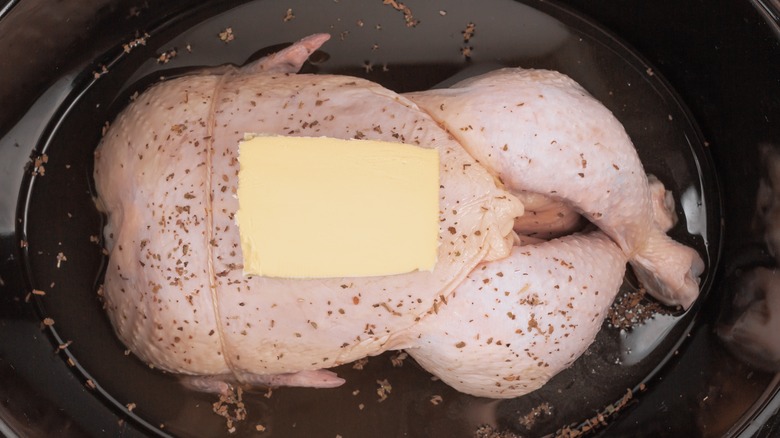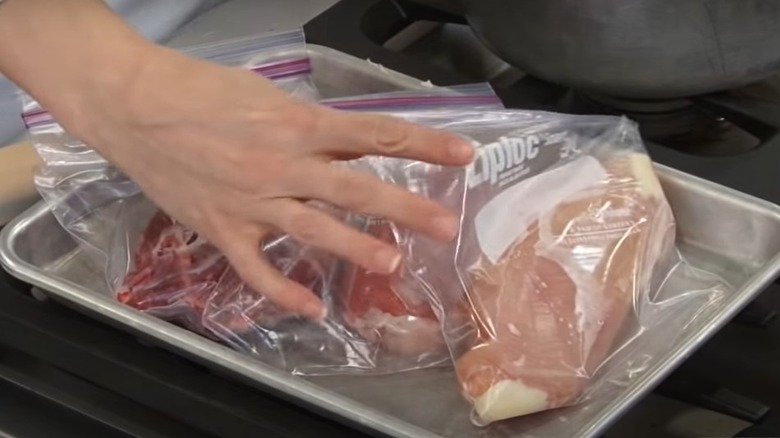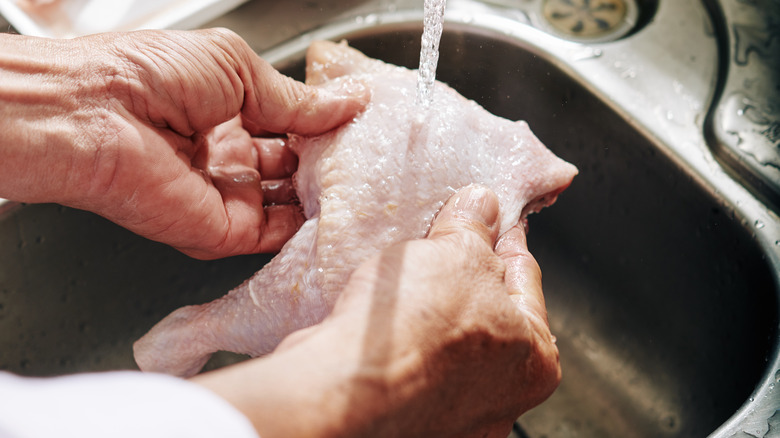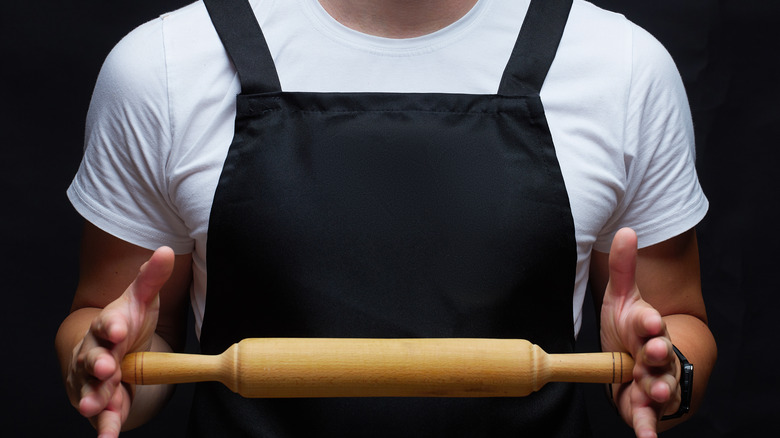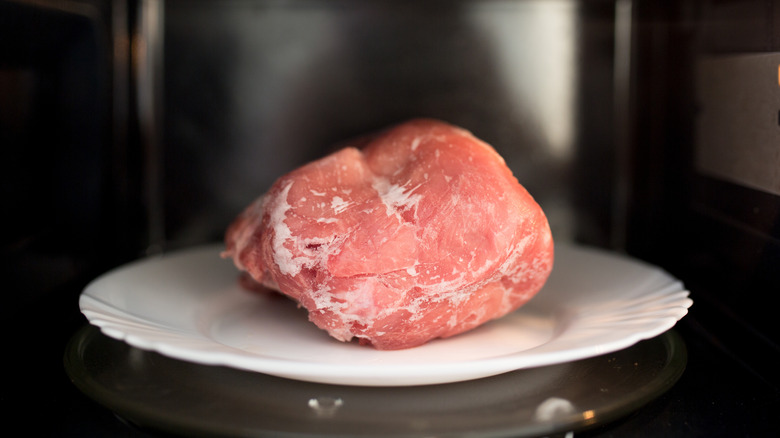The Absolute Best And Worst Ways To Thaw Meat
We may receive a commission on purchases made from links.
Like the great Dr. Leo Spaceman (played by Chris Parnell on "30 Rock"), we're always eager to help humans ingest more meat (though we can't say whether or not animal blood keeps the spine straight). While we undoubtedly respect (and often write about!) vegetarian and vegan diets and lifestyles, we also believe in the magical powers derived from animal-based protein — and are big proponents of the food chain as a result.
Now, obtaining consistent meat in the 21st century is far from challenging given the modern miracle that is refrigeration. After all, freezers can preserve various types of meat for months, or even years, at a time (via FoodSafety.gov). Of course, since we aren't cartoon polar bears living in the arctic (if only), we can't enjoy a juicy pulled pork sandwich or a tender tomahawk steak if it's still frozen solid.
Fortunately, there's numerous ways to defrost a piece of meat, though some thawing methods offer a safer path (as well as a more delectable final product) than others. If you're as eager as we are to ensure your daily animal protein is ready to be cooked when you need it, but are unsure of the best way to successfully defrost meat — we've got you covered. Depending on your preference, the type of meat you're working with, and the time you have available, here are the absolute best and worst ways to thaw meat.
Best: In the fridge on the bottom shelf
Realistically, there's one thawing method that exceeds all others, and likely takes the cake as both the safest (and most reliable) way to thaw meat. If you've got plenty of time to plan ahead, and are able to begin your meat preparation at least 24 hours in advance, nothing beats placing the frozen meat on a dish (or in a sealed container), and letting it defrost in the fridge on the bottom shelf. After all, letting meat defrost in the fridge keeps in at a consistently safe temperature while thawing, which drastically reduces the risk of food poisoning when you finally ingest it (via USDA).
More than anything else, thawing meat in a refrigerator ensures the food remains outside of the so-called "Danger Zone" for microbial growth — which occurs between 40 and 140 degrees Fahrenheit. Since the ideal fridge temperature is around 37 degrees (via Consumer Reports), there's little to no concern about dangerous food borne pathogens proliferating on your meat while it thaws in the fridge.
As for the bottom shelf aspect, this will diminish the chances of any liquid from the defrosting (and raw) meat contaminating other food items. After all, raw meat juices can be chock full of potentially harmful bacteria (via Minnesota Department of Health). Plus, who wants to see a thawing steak's blood-red juices dripping down onto their eggs, vegetables, or milk?
Worst: In hot water
To be perfectly honest, there's plenty of potential ways to take an ice cold, frozen-solid piece of meat and make sure it ends up completely thawed. However, given the inherent risk of bacteria growing on meat's surface as it defrosts — when it rests for too long in the "Danger Zone," discussed above – some methods, like thawing in hot water, simply aren't worth the risk.
Now, the USDA clearly states one should never thaw meat in hot water due to the risk of food borne pathogens developing in the process. But, in addition to the health concerns brought on by this method, thawing meat in hot water can lead to issues with the meat's quality, as well. After all, thawing in hot water may cause a meat's exterior to start cooking while the interior remains frozen — which severely reduces the chance for creating an evenly-cooked, tender end product. If you're pressed for time, you may be tempted to throw caution to the wind and toss a frozen piece of meat in hot water to quickly defrost it, but seeing as there are other time-friendly and safe methods (more on those shortly), it's clear why using hot water is one of the worst ways to thaw meat.
Best: In cold water
This isn't the first time we're acknowledging the risk of bacterial growth when categorizing a meat-thawing method (nor will it be the last, given the subject matter). But what can we say? Some defrosting techniques are simply tried and true, ensuring no one succumbs to food poisoning, while sustaining the quality of the meat in question. Submerging frozen meat in cold water belongs among the best ways to thaw meat — as long as you keep it in an airtight, water-sealed container, and make certain the water remains cold the entire time (via USDA).
Obviously, considering the "Danger Zone" temperature for bacterial growth on meat ranges between 40 and 140 degrees Fahrenheit, it's crucial the water used for defrosting meat remains below 40 degrees when thawing this way. This can be done by consistently checking the water's temperature (at least once every 30 minutes), and changing it if necessary, according to Michigan State University. Of course, according to the National Restaurant Association Educational Foundation, you can bypass the need to check the water's temperature by using flowing cold water instead. Just be sure you keep the meat in a sealed container to avoid water-logging it, and lower the odds of contaminated water leaking out of the pot.
Worst: In the dishwasher
As demonstrated by the concept of AI-generated essays from the (un)surprisingly popular ChatGPT, humans aren't always prone to thoughtfulness before embarking on an absurd endeavor. So, while you may be quick to attempt defrosting meat in the dishwasher just because you can (knowing it's somehow possible to cook salmon in the kitchen appliance), you'd be wise to steer clear of this horrible thawing technique.
According to the USDA, you should never consider using your dishwasher to thaw meat due to the risk of bacteria growing in the process. Of course, while those food safety concerns help push this thawing method into the worst category, we're more turned off by the ludicrous notion of using a dishwasher for anything beyond cleaning. After all, as evidenced by this article, there are numerous better ways to thaw meat other than throwing it in the dishwasher — so why would you try this supposed hack in lieu of more efficient (and dependable) ways? Maybe some of us simply spent too much time watching "Wild and Crazy Kids" on Nickelodeon growing up, given how often we're driven to act in, well, wild and crazy ways. But if you're thinking of doing something as bizarre as using the dishwasher to thaw meat — don't bother.
Best: The two pot method
Some of the best ways to thaw animal-derived proteins aren't necessarily applicable to each and every type of meat. Case in point: the two pot thawing method (as shown on The Doctors), which appears mainly feasible for quickly defrosting a piece of steak through the process of conduction. And thaw it does, as the two pot method offers the opportunity to defrost a frozen steak in as little as 5 minutes.
In addition to the swift speed with which steak thaws through this technique, the two pot method is also supremely easy to execute. You'll need two metal pots, of course: one empty and turned upside down (on top of which you'll place the frozen, package-sealed steak), and a second filled with room temperature water. After you fill the second pot with water, you simply stack it on top of the steak, and leave the steak between the pots until it's ready to roll — into your pan, onto the grill, or wherever you're cooking it. If you're in a bind for time, this thawing method may do the trick — as well as make you wonder why you ever bothered with a slow, standard defrosting technique in the first place.
Worst: On the counter
If we're being perfectly honest, we can't pretend we've never defrosted a piece of meat on the counter before — or on the kitchen table, or, well, anywhere at room temperature. But we suppose we've been (knock on wood) lucky to have avoided any food borne pathogens in our past processes, because according to the USDA, you should never thaw meat at room temperature if you want to completely avoid any risk of food poisoning.
Now, there may be a chef (or 50) reading this article who scoff at the notion and can't understand why this thawing method would be listed among the "worst" ways available. Quite frankly, many chefs believe it's blasphemy to put cold meat in a hot pan, and encourage letting meat sit out to supposedly warm it up to room temperature before cooking. But letting a fully-thawed piece of meat sit at room temperature for a short period of time before cooking is far different than allowing it to defrost for hours on end. After all, raw meat can stay relatively safe for consumption if left at room temperature for up to two hours — or, only one hour if the temperature is 90 degrees Fahrenheit or above (via USDA). But any longer than that, and the chances of consuming spoiled and/or bacteria-ridden meat is too great to risk.
Best: Not defrosting at all (when using a pressure cooker or slow cooker)
Now, unless you're interested in noshing on a meat popsicle of some sort — and since you're not a wild animal roaming Siberia, we'll assume you aren't — we know you're only looking to consume meat once it's fully cooked. But, that doesn't mean your eventual meal needs to be thawed entirely before you start the cooking process. In fact, if you're using a slow cooker or a pressure cooker, one of the best ways to thaw meat is not to thaw it at all (via Michigan State University).
Of course, while there's little to no food safety risk if you start your cooking process with frozen meat (via USDA), some cooking methods are likely to doom the food item before it hits your plate. After all, you can't expect a frozen piece of meat to completely thaw, or cook evenly, if you utilize a high-heat, quick-cooking technique. That being said, if you use a frozen piece of meat in a slow cooker or a pressure cooker (like an Instant Pot), it greatly lowers the risk of ending up with an unappetizing, uneven final product. Not only that, but these cooking techniques ensure meat remains outside of the "Danger Zone" range while going from frozen to fully cooked.
Worst: Inside a car or trunk
As evidenced by far too many instances of dogs being left inside unventilated vehicles on sweltering summer days, the interior of a car is more than hot enough to defrost a piece of meat. But the dangers of a windows-rolled-up vehicle perfectly illustrate why attempting to thaw meat inside a car or trunk is inadvisable. After all, the odds are high that a car's interior temperature falls squarely in the "Danger Zone" for bacteria growth, according to the USDA.
Now, leaving a raw piece of meat in the "Danger Zone" range for a very short period doesn't automatically spur bacteria production, but similar to the issues found with thawing meat on a counter at room temperature, problems begin to arise if raw meat is left out for more than two hours at such temperatures. Since frozen meat won't fully defrost that quickly, it's clear why leaving it in a car or trunk is one of the worst ways to thaw meat. So, if you're considering leaving frozen meat in your car after grocery shopping, you may want to rethink that plan.
Best: In warm water (with small cuts of meat)
Seeing as we've mentioned it several times so far, you're likely aware the '"Danger Zone" for potential bacterial growth takes place when meat rests between 40 and 140 degrees Fahrenheit for an extended period of time. Yet, according to America's Test Kitchen, you can actually safely defrost smaller cuts of meat (those one-inch thick or less) in water at, or just above, 140 degrees. Now, there are several key points to keep in mind when thawing meat in warm water.
First, since we know defrosting meat in hot water can be dangerous, you want to make sure the water is warm rather than hot before you begin the thawing process. Therefore, be sure you check the water's temperature before placing frozen meat into it. Additionally, it's important to keep the meat in a sealed, waterproof bag before submerging it in water, while ensuring it doesn't remain in the warm water for too long. America's Test Kitchen suggests leaving frozen meat in warm water no more than 45 minutes (to reduce the risk of it starting to cook, or growing bacteria), though the length of thawing time will change depending on the meat.
Worst: Running under water without packaging
As we mentioned earlier, one of the most well-known and widely-used methods for safely thawing meat is placing it in cold water in a sealed, airtight bag. Of course, the logic for using a sealed container to defrost meat goes beyond the need to minimize the risk of bacteria developing on the meat itself. In fact, one of the main reasons to avoid thawing meat under running water without packaging is the danger of the bacteria splashing onto items around the sink (via CDC) — which may contaminate your kitchen in the process.
Now, while the incomparable Julia Child was known to rinse raw chicken before cooking it (via NPR), the bottom line is that washing chicken to defrost it (or any meat, for that matter) is a bad idea. In fact, while running frozen chicken under water may eventually thaw it out enough to cook, it doesn't remove any potentially harmful microbes, according to University of Wisconsin – with one study showing bacteria was still present on raw poultry after rinsing it 40 times. If anything, rinsing meat runs the risk of displacing any harmful bacteria, and causing cross contamination.
Best: Pounding it between parchment paper
When it comes to the best and worst ways to thaw meat, most of the suggested techniques we've listed can be used for just about any type of meat. But, some methods shouldn't be used universally, and are far better suited to specific types and cuts of meat than others. This includes pounding the meat between pieces of parchment paper on a cutting board, which can be an excellent technique for thawing meat — as long as it's ground meat, thin cuts, or meat that's already partially defrosted (via MasterClass).
Interestingly, the pounding-in-parchment technique doesn't actually involve, well, pounding the meat into oblivion using a meat tenderizer. In fact, since this method involves pressing the frozen meat onto a cutting board with a rolling pin, it may be more apt to describe it as a squeezing or crushing technique. Of course, semantics aside, the fact remains this method can be used to more quickly thaw out a thinner (or already-slightly defrosted) piece of meat.
Worst: In the microwave (even though it's safe)
Let's say we were presenting the safest ways to thaw meat. If that were the case, then using the microwave would undoubtedly slot in as one of the best ways for defrosting. But while thawing meat in the microwave is perfectly safe, according to the USDA, it's also quite likely to result in one of the least appetizing, rubber shoe-adjacent meals in the process. To be clear, we're not here to bash the microwave, or denigrate the many wonderful ways the appliance simplifies the cooking process for chefs (professional and amateur alike). For all the undeniably helpful aspects afforded by a microwave, there's ample reason you'll want to reconsider the defrost button — particularly when it comes to thawing meat.
More than anything, as chef Rachel Ardee told Reader's Digest, the problem with thawing meat in the microwave is that it "may also start to cook the item a little on the outside," while it remains cold and frozen inside. Not only is this not super efficient, but it "makes cooking the meat much more difficult." In other words, if you're hoping for a perfectly tender, juicy, and evenly-cooked piece of meat, skip the microwave when thawing your protein.
